2. 成都市环境保护科学研究院, 成都 610072
2. Chengdu Academy of Environmental Sciences, Chengdu 610072, China
近年来的秋冬季节, 空气重污染事件在全国范围内频繁出现, 其中京津冀、长江三角洲、珠江三角洲和四川盆地地区为霾高发区, 以高颗粒物浓度和低能见度为特征的重污染事件已经成为科研工作者和民生关注的焦点[1~3].大气能见度是反映大气透明度的指标, 也是反映环境空气质量的视觉指标, 相对湿度(RH)和颗粒物浓度是影响大气能见度的主要影响因素.于兴娜等[4]分析了南京RH和气溶胶组分对大气能见度下降的影响, 研究结果显示高气溶胶浓度和RH是造成南京市低能见度事件的两个重要因素, 当RH>80%时, 颗粒物吸湿增长对大气能见度下降有更显著的作用.
RH是颗粒物理化和光学特性的重要影响因素, 会影响颗粒物的吸湿增长、粒径分布、气态前体物的气粒转化等特性[5~7].当环境中RH较高时, 颗粒物中硫酸盐、硝酸盐和铵盐等具有吸湿特性的成分会吸湿增长, 粒径变大, 消光能力显著增强, 导致能见度降低[8, 9].此外, RH通过影响颗粒物表面液相非均相反应影响无机气溶胶二次生成, RH升高能促进颗粒物表面二次无机组分(硫酸盐、硝酸盐和铵盐)的积累, 导致颗粒物浓度增加[10]. Sun等[11]对北京市霾期间颗粒物特征进行分析, 发现RH与硫氧化率(SOR)和氮氧化率(NOR)显著相关, 相关性系数分别为0.96和0.88, 表明较高的RH可以促进硫酸盐和硝酸盐二次转化过程. Wang等[12]对四川盆地气溶胶消光性质进行研究, 发现成都市2015年冬季硫酸铵和硝酸铵对消光的贡献超过60%.可见, RH对颗粒物浓度升高、二次无机盐生成和能见度下降有重要影响.
成都作为西南地区最大的以高湿度为特征的城市, 属于亚热带湿润季风气候区, 雨量充沛, 典型的气象特征是高湿度低风速, 近几年, 成都平原城市地区发生多次大面积较长时间区域性霾污染事件[13, 14].然而, 成都市的高RH对颗粒物浓度和二次无机盐生成以及大气能见度的影响尚未见报道.鉴于此, 本研究拟利用成都市城区2015年12月的连续在线观测数据, 如RH、大气能见度、颗粒物(PM10、PM2.5和PM1)浓度、气态污染物(SO2和NO2)浓度以及PM2.5中SO42-和NO3-浓度等, 探讨RH对颗粒物浓度和二次无机盐生成以及大气能见度的影响, 以期为进一步改善成都地区大气能见度提供理论支撑.
1 材料与方法 1.1 观测地点及时间冬季霾天气过程频发, 因此, 本次观测时间定为2015年12月.观测点位于成都市青羊区成都市环境保护科学研究院楼顶(7楼, 距离地面21 m, 30°39′N, 104°02′E), 靠近锦江, 四周2 km内无高大建筑物, 视野开阔、气流稳定, 附近5 km范围内无明显工业大气污染源, 属于典型的居住区.研究表明, 该观测点在一定程度上可代表成都市城区的大气污染水平[15].
1.2 观测仪器PM10、PM2.5和PM1均采用微量振荡天平法(Thermo TEOM Series 1405, USA)在线、实时分析.气态污染物SO2和NO2的体积浓度分别由脉冲荧光SO2分析仪(Thermo 43i, USA)和化学发光NO-NO2-NOx分析仪(Thermo 42i, USA)进行监测.采用基于旋转湿式扩散管气体吸收技术和气溶胶蒸汽捕集技术的在线气体与气溶胶成分监测仪(Fortelice, IGAC S-611EG, 中国台湾)与离子色谱仪(DIONEX ICS-2100 & ICS-1100)联用来测定PM2.5中水溶性离子组分SO42-和NO3-, 离子交换色谱柱型号分别为IonPac AS18和IonPac CS12A.气象要素(大气能见度、RH、温度和风速)采用德国LUFFT WS600一体式气象站进行监测.所有监测数据经过异常值筛选和剔除后统一处理为小时均值.
2 结果与讨论 2.1 RH与颗粒物浓度及大气能见度的总体特征整个观测期间, 基本无降雨事件, 风速偏低, 平均风速为(0.95±0.37) m·s-1, 平均气温为(9.87±2.35)℃.观测期间, 成都市的RH和大气能见度、各粒径段颗粒物质量浓度及其与PM10比值的逐时变化如图 1所示, 其中, PM1~2.5和PM2.5~10分别指的是空气动力学当量直径在1~2.5 μm和2.5~10 μm的颗粒物.可以看出, 当RH较低时, 大气能见度较高, RH和大气能见度的负相关关系明显, 尤其是观测后期, 随RH增大, 颗粒物浓度持续升高, 大气能见度骤降.
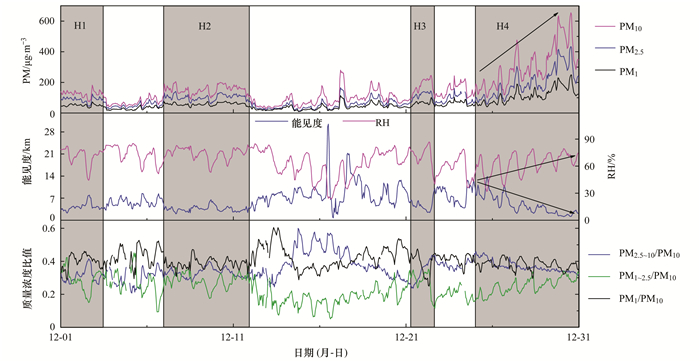
|
图 1 观测期间RH、能见度和颗粒物质量浓度及其与PM10质量浓度比值的逐时变化 Fig. 1 Hourly variations of RH, visibility, particulate mass concentrations, and their ratio to PM10 concentration during the observation period |
表 1列出了观测期间RH、大气能见度、颗粒物质量浓度及其与PM10质量浓度比值的统计结果.平均RH为(66.53±13.12)%, 平均大气能见度为(5.89±3.47) km, PM2.5平均浓度为(103.33±75.46) μg·m-3, PM2.5~10、PM1~2.5和PM1在PM10中的比值分别为0.36、0.24和0.40.总体来说, 成都市冬季颗粒物浓度较高, 其中亚微米颗粒物(即PM1)对PM10质量浓度贡献最大, 说明成都市冬季气溶胶中细颗粒物污染较为严重.
|
|
表 1 观测期间RH、能见度和颗粒物质量浓度及与PM10质量浓度比值的统计特征 Table 1 Statistical characteristics of RH, visibility, particulate mass concentrations, and their ratio to PM10 concentration during the observation period |
结合中国气象局对霾的定义(大气能见度 < 10.0 km, RH < 90%)和《环境空气质量标准》, 观测期间发生4次时间较长且PM2.5浓度超过环境空气质量二级浓度限值(75 μg·m-3)的霾天气过程, 如图 1中阴影部分所示, 4次霾过程的持续时间、大气能见度、RH、颗粒物质量浓度及其与PM10质量浓度比值的均值如表 2所示.霾过程持续时间最短为29 h(过程3), 最长为168 h(过程4).
|
|
表 2 霾天气与非霾天气下RH、能见度、颗粒物质量浓度及其与PM10质量浓度比值的均值 Table 2 Average data of RH, visibility, particulate mass concentrations, and their ratio to PM10 mass concentration under the haze and non-haze episodes |
霾过程与非霾过程相比, 有以下4个特征:①颗粒物浓度较高; ②大气能见度较低; ③PM1~2.5/PM10显著上升; ④RH增大.如图 1可知, 在霾过程4中, 随RH从35%持续增大至75%, PM2.5浓度从79 μg·m-3暴发式增长到观测期间的峰值434 μg·m-3, 大气能见度也由10 km降至1.5 km左右.由表 2可知, 在4个霾过程中, 霾过程2的平均RH最高, 为73.92%, PM2.5平均浓度为101.50 μg·m-3, 平均能见度最低, 仅为3.60 km; 霾过程4的平均RH最低, 为64.76%, PM2.5平均浓度为204.51 μg·m-3, 平均能见度为4.34 km.可以看出, RH的变化对霾的形成过程有重要影响, 与其他霾过程研究结果一致, 高RH和高颗粒物浓度协同对大气能见度降低以及霾过程形成起作用[16, 17].
2.2 RH对颗粒物浓度和能见度的影响已有研究表明, 能见度与气溶胶质量浓度及RH呈负相关关系[18, 19].观测期间, RH变化幅度较大, RH与能见度及各粒径段颗粒物与PM10质量浓度比值的关系如图 2所示.随RH升高, PM1/PM10变化不大; RH从<40%增长至80%~90%, PM1~2.5/PM10增长了146%, PM2.5~10/PM10降低了36.2%.表明成都市RH越高, 细颗粒物污染特征越明显.随着RH从0~40%升高到80%~90%, 能见度下降了35.1%.可以看出, RH升高对能见度的恶化和细颗粒物污染加重影响很大[20].
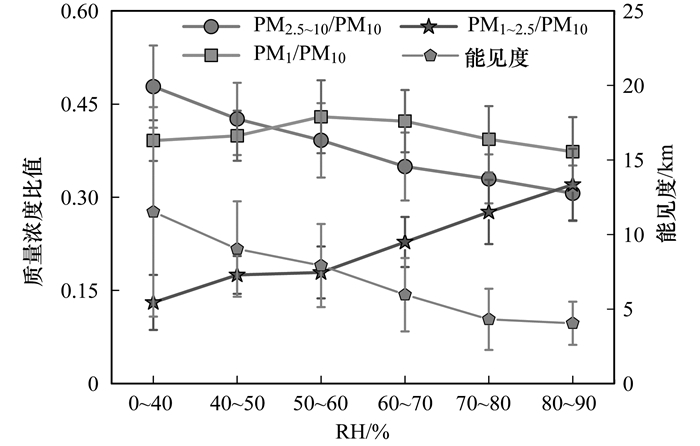
|
图 2 RH与能见度及不同粒径段颗粒物与PM10质量浓度比值的关系 Fig. 2 Relationship between RH, visibility, and mass concentration ratio of particulate matters with different diameters to that of PM10 |
图 3给出了不同RH区间内PM2.5浓度与能见度的散点图及拟合曲线.可以看出, 在各个RH范围内, 随着PM2.5浓度的增加, 能见度都呈幂指数下降, 这种下降趋势在PM2.5浓度较低时(< 75 μg·m-3)表现得尤为明显.比如, RH在50%~60%时, PM2.5从50 μg·m-3增长到100 μg·m-3, 能见度从10 km降低到7 km, 能见度对于PM2.5增长的变化率(Δ能见度/ΔPM2.5)为-0.06 km/(μg·m-3); PM2.5从150 μg·m-3增长到200 μg·m-3, 能见度从6 km降低到5 km, 能见度对于PM2.5增长的变化率为-0.02 km/(μg·m-3).
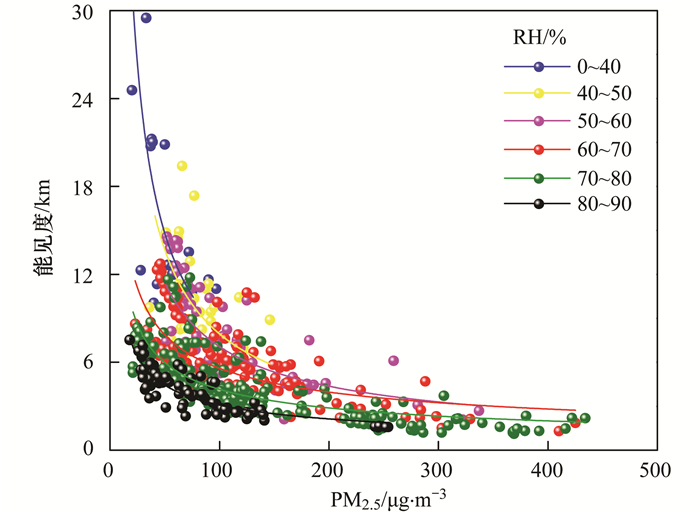
|
图 3 PM2.5浓度与能见度及RH的关系 Fig. 3 Relationship between PM2.5 concentration, visibility, and RH |
图 3也显示, 在PM2.5浓度较低时, 较高的RH条件下能见度也会显著降低.比如在PM2.5浓度为50 μg·m-3的条件下, RH为50%~60%时, 能见度大约11 km; RH为70%~80%时, 能见度大约5 km.这是由于PM2.5中的吸湿组分吸湿增长, 粒径增大, 显著增强了对光的散射作用, 导致能见度降低[21, 22].可见, 当颗粒物浓度较低时, 不同RH区间内能见度差异较大, RH对能见度的影响较强; 当颗粒物浓度较高时, 不同RH区间内能见度差异不大, 说明此时大气消光主要由PM2.5浓度控制, RH对能见度的影响减弱.
2.3 RH对PM2.5中二次无机盐生成的影响PM2.5中含量最高的水溶性无机组分是硫酸盐和硝酸盐, 来源于直接排放和二次转化生成.大气中SO2和NO2被羟基自由基或O3等氧化剂经过一系列复杂的大气化学反应氧化生成硫酸和硝酸, 然后和气态NH3反应, 生成二次无机组分硫酸铵和硝酸铵[23].通常用SOR和NOR分别作为SO2和NO2二次转化程度的指示参数[24, 25]. SOR和NOR定义为:

|
式中,n代表物质的量[26](mol).
有研究指出, 当SOR的值大于0.1时, 就说明环境空气中的SO2发生了一系列的光化学反应生成二次硫酸盐, 且SOR和NOR的数值越高, 代表SO2和NO2被氧化生成二次硫酸盐和硝酸盐越多[27].
RH是SO2和NO2在颗粒物表面进行非均相氧化反应过程的重要影响因素[28].根据上式计算得到的SOR、NOR与RH的时间序列如图 4所示, 总体来看, SOR和NOR与RH基本呈现同升同降的变化趋势.整个观测期间, SOR和NOR的均值分别为0.37和0.17. RH小于40%时, SOR和NOR的均值分别为0.27和0.11; RH大于70%时, SOR和NOR的均值分别增长至0.40和0.19.这表明成都市冬季PM2.5中的硫酸盐和硝酸盐通过二次转化生成的贡献很大, 较高的RH对二次硫酸盐和硝酸盐生成促进作用显著.
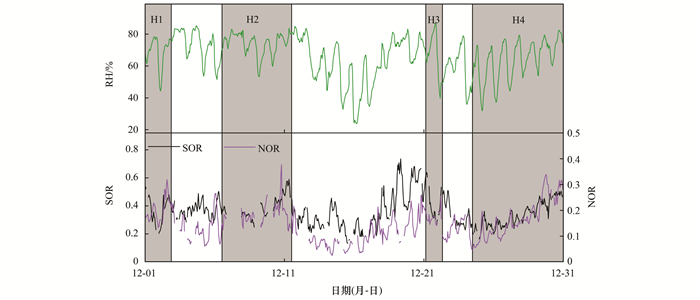
|
图 4 观测期间RH与SOR和NOR的时间序列 Fig. 4 Hourly variations of RH, SOR, and NOR during the observation period |
为了研究不同天气条件下RH对二次硫酸盐和硝酸盐生成的影响, 图 5给出了整个观测期间、非霾过程和4个霾过程的RH与SOR和NOR的关系.可以看出, 整个观测期间, 随着RH增加(>60%), SOR和NOR呈上升趋势, 4个霾过程的SOR和NOR值基本上均大于非霾期间的SOR和NOR值.对于不同霾过程, RH对二次硫酸盐和硝酸盐生成的作用不同.霾过程1和4, 随RH升高, SOR和NOR均有较大的增长, 表明两个过程中通过非均相化学反应生成的二次硫酸盐和硝酸盐协同对大气能见度的降低起作用; 霾过程2, 随RH升高, SOR变化不明显, 一直保持在高值段, 而NOR缓慢增长, 表明此过程主要是二次硫酸盐大量生成导致能见度降低; 霾过程3, 随RH升高, SOR先升高, 后下降, NOR变化不明显, 表明还是二次硫酸盐对空气质量恶化起重要作用.通过以上分析可知, 不同霾过程, RH对二次硫酸盐和硝酸盐生成的促进作用不同, 影响空气质量的主要二次无机盐有所区别.
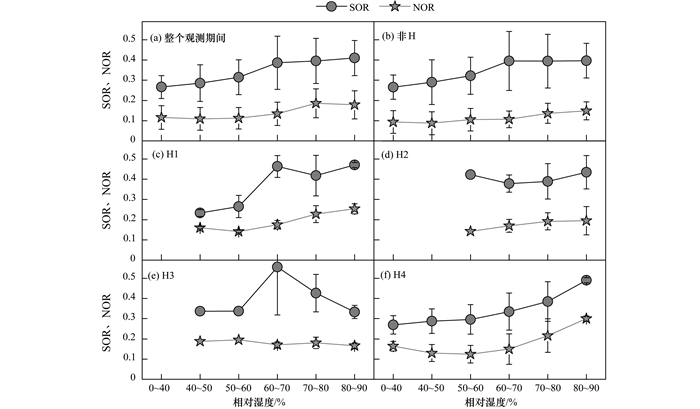
|
图 5 整个观测期间、非霾期间、4个霾过程的RH与SOR和NOR的关系 Fig. 5 Relationship between RH and SOR and NOR during the entire observation period, non-haze period, and the four haze episodes |
(1) 观测结果表明, 成都市冬季气溶胶中细颗粒物污染较为严重.随RH升高, PM1~2.5/PM10增长了146%, PM2.5~10/PM10降低了36.2%, 表明成都市RH越高, 细颗粒物污染特征越明显, 能见度的恶化和细颗粒物污染加重与RH升高关系较大.
(2) 在不同RH区间内, 随着PM2.5浓度的增加, 能见度都呈幂指数下降.当颗粒物浓度较低时, RH对能见度的影响作用较强; 当颗粒物浓度较高时, 大气消光主要由PM2.5浓度控制, RH对能见度的影响减弱.
(3) 整个观测期间, 随RH升高, SOR和NOR显著增大, 表明RH对二次硫酸盐和硝酸盐生成促进作用显著.不同霾过程, RH对二次硫酸盐和硝酸盐生成的促进作用不同, 二次硫酸盐和硝酸盐单独或协同影响空气质量.
| [1] | Zhang X Y, Wang Y Q, Niu T, et al. Atmospheric aerosol compositions in China:spatial/temporal variability, chemical signature, regional haze distribution and comparisons with global aerosols[J]. Atmospheric Chemistry and Physics, 2012, 12(2): 779-799. DOI:10.5194/acp-12-779-2012 |
| [2] | Bi J R, Huang J P, Hu Z Y, et al. Investigating the aerosol optical and radiative characteristics of heavy haze episodes in Beijing during January of 2013[J]. Journal of Geophysical Research:Atmospheres, 2014, 119(16): 9884-9900. DOI:10.1002/2014JD021757 |
| [3] | Fu Q Y, Zhuang G S, Wang J, et al. Mechanism of formation of the heaviest pollution episode ever recorded in the Yangtze River Delta, China[J]. Atmospheric Environment, 2008, 42(9): 2023-2036. DOI:10.1016/j.atmosenv.2007.12.002 |
| [4] |
于兴娜, 马佳, 朱彬, 等. 南京北郊秋冬季相对湿度及气溶胶理化特性对大气能见度的影响[J]. 环境科学, 2015, 36(6): 1919-1925. Yu X N, Ma J, Zhu B, et al. Effects of relative humidity and aerosol physicochemical properties on atmospheric visibility in northern suburb of Nanjing[J]. Environmental Science, 2015, 36(6): 1919-1925. |
| [5] | Ye X N, Tang C, Yin Z, et al. Hygroscopic growth of urban aerosol particles during the 2009 Mirage-Shanghai Campaign[J]. Atmospheric Environment, 2013, 64: 263-269. DOI:10.1016/j.atmosenv.2012.09.064 |
| [6] | Wang L, Ji D S, Li Y, et al. The impact of relative humidity on the size distribution and chemical processes of major water-soluble inorganic ions in the megacity of Chongqing, China[J]. Atmospheric Research, 2017, 192: 19-29. DOI:10.1016/j.atmosres.2017.03.016 |
| [7] | Zhao Y, Liu Y C, Ma J Z, et al. Heterogeneous reaction of SO2 with soot:The roles of relative humidity and surface composition of soot in surface sulfate formation[J]. Atmospheric Environment, 2017, 152: 465-476. DOI:10.1016/j.atmosenv.2017.01.005 |
| [8] | Hu D W, Chen J M, Ye X N, et al. Hygroscopicity and evaporation of ammonium chloride and ammonium nitrate:Relative humidity and size effects on the growth factor[J]. Atmospheric Environment, 2011, 45(14): 2349-2355. DOI:10.1016/j.atmosenv.2011.02.024 |
| [9] | Day D E, Malm W C. Aerosol light scattering measurements as a function of relative humidity:a comparison between measurements made at three different sites[J]. Atmospheric Environment, 2001, 35(30): 5169-5176. DOI:10.1016/S1352-2310(01)00320-X |
| [10] | Quan J N, Liu Q, Li X, et al. Effect of heterogeneous aqueous reactions on the secondary formation of inorganic aerosols during haze events[J]. Atmospheric Environment, 2015, 122: 306-312. DOI:10.1016/j.atmosenv.2015.09.068 |
| [11] | Sun Y L, Zhuang G S, Tang A, et al. Chemical characteristics of PM2.5 and PM10 in haze-fog episodes in Beijing[J]. Environmental Science & Technology, 2006, 40(10): 3148-3155. |
| [12] | Wang H B, Shi G M, Tian M, et al. Aerosol optical properties and chemical composition apportionment in Sichuan Basin, China[J]. Science of the Total Environment, 2017, 577: 245-257. DOI:10.1016/j.scitotenv.2016.10.173 |
| [13] | Li L L, Tan Q W, Zhang Y H, et al. Characteristics and source apportionment of PM2.5 during persistent extreme haze events in Chengdu, southwest China[J]. Environmental Pollution, 2017, 230: 718-729. DOI:10.1016/j.envpol.2017.07.029 |
| [14] | Liao T T, Wang S, Ai J, et al. Heavy pollution episodes, transport pathways and potential sources of PM2.5 during the winter of 2013 in Chengdu (China)[J]. Science of the Total Environment, 2017, 584-585: 1056-1065. DOI:10.1016/j.scitotenv.2017.01.160 |
| [15] |
瞿群, 杨毅红, 宋丹林, 等. 成都典型秸秆燃烧季节PM2.5中化学成分研究[J]. 气候与环境研究, 2016, 21(4): 439-448. Qu Q, Yang Y H, Song D L, et al. Chemical characterization of PM2.5 at urban Chengdu during the typical biomass burning season[J]. Climatic and Environmental Research, 2016, 21(4): 439-448. |
| [16] | Yang Y R, Liu X G, Qu Y, et al. Characteristics and formation mechanism of continuous hazes in China:a case study during the autumn of 2014 in the North China Plain[J]. Atmospheric Chemistry and Physics, 2015, 15(14): 8165-8178. DOI:10.5194/acp-15-8165-2015 |
| [17] | Li H, Ma Y L, Duan F K, et al. Typical winter haze pollution in Zibo, an industrial city in China:characteristics, secondary formation, and regional contribution[J]. Environmental Pollution, 2017, 229: 339-349. DOI:10.1016/j.envpol.2017.05.081 |
| [18] | Wang J L, Zhang Y H, Shao M, et al. Quantitative relationship between visibility and mass concentration of PM2.5 in Beijing[J]. Journal of Environmental Sciences, 2006, 18(3): 475-481. |
| [19] |
刘瑞婷, 韩志伟, 李嘉伟. 北京冬季雾霾事件的气象特征分析[J]. 气候与环境研究, 2014, 19(2): 164-172. Liu R T, Han Z W, Li J W. Analysis of meteorological characteristics during winter haze events in Beijing[J]. Climatic and Environmental Research, 2014, 19(2): 164-172. DOI:10.3878/j.issn.1006-9585.2014.13224 |
| [20] |
吴兑, 刘放汉, 梁延刚, 等. 粤港细粒子(PM2.5)污染导致能见度下降与灰霾天气形成的研究[J]. 环境科学学报, 2012, 32(11): 2660-2669. Wu D, Liu F H, Liang Y G, et al. Hazy weather formation and visibility deterioration resulted from fine particulate (PM2.5) pollutions in Guangdong and Hong Kong[J]. Acta Scientiae Circumstantiae, 2012, 32(11): 2660-2669. |
| [21] | Dougle P G, Vlasenko A L, Veefkind J P, et al. Humidity dependence of the light scattering by mixtures of ammonium nitrate, ammonium sulfate and soot[J]. Journal of Aerosol Science, 1996, 27(1): S513-S514. |
| [22] | Malm W C, Day D E. Estimates of aerosol species scattering characteristics as a function of relative humidity[J]. Atmospheric Environment, 2001, 35(16): 2845-2860. DOI:10.1016/S1352-2310(01)00077-2 |
| [23] | Wang X F, Wang W X, Yang L X, et al. The secondary formation of inorganic aerosols in the droplet mode through heterogeneous aqueous reactions under haze conditions[J]. Atmospheric Environment, 2012, 63: 68-76. DOI:10.1016/j.atmosenv.2012.09.029 |
| [24] | Wang S S, Nan J L, Shi C Z, et al. Atmospheric ammonia and its impacts on regional air quality over the megacity of Shanghai, China[J]. Scientific Reports, 2015, 5: 15842. DOI:10.1038/srep15842 |
| [25] | Du H H, Kong L D, Cheng T T, et al. Insights into summertime haze pollution events over Shanghai based on online water-soluble ionic composition of aerosols[J]. Atmospheric Environment, 2011, 45(29): 5131-5137. DOI:10.1016/j.atmosenv.2011.06.027 |
| [26] | Han T T, Liu X G, Zhang Y H, et al. Characteristics of aerosol optical properties and their chemical apportionments during CAREBeijing 2006[J]. Aerosol and Air Quality Research, 2014, 14(5): 1431-1442. |
| [27] | Ram K, Sarin M M, Sudheer A K, et al. Carbonaceous and secondary inorganic aerosols during wintertime fog and haze over urban sites in the Indo-Gangetic Plain[J]. Aerosol and Air Quality Research, 2011, 12(3): 359-370. |
| [28] | Liu X G, Li J, Qu Y, et al. Formation and evolution mechanism of regional haze:a case study in the megacity Beijing, China[J]. Atmospheric Chemistry and Physics, 2013, 13(9): 4501-4514. DOI:10.5194/acp-13-4501-2013 |
 2018, Vol. 39
2018, Vol. 39


